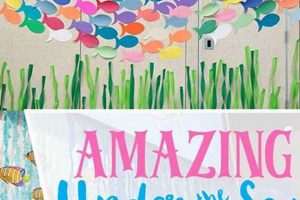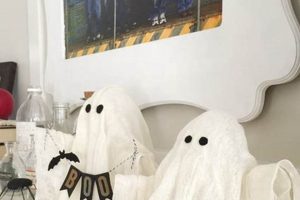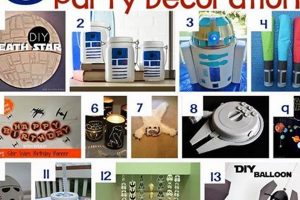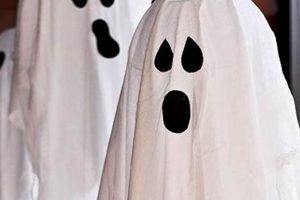Handcrafted environmental enrichments for Pogona vitticeps habitats represent a cost-effective and personalized approach to reptile husbandry. These creations encompass a range of items, from basking platforms constructed from slate tile and secured with reptile-safe silicone, to climbing structures fashioned from cleaned and disinfected branches sourced from pesticide-free environments.
Providing such customized elements within a bearded dragon enclosure promotes physical activity, reduces stress through increased environmental complexity, and allows for thermoregulatory optimization. Historically, reptile enclosures often lacked sufficient enrichment, leading to behavioral issues and reduced overall well-being. Prioritizing enriching environments through creative solutions demonstrates a commitment to responsible reptile ownership and the animals physiological and psychological health.
The subsequent sections will delve into specific examples of habitat modifications, material selection guidelines, construction techniques, and safety considerations essential for the successful implementation of custom-designed enclosure components, ensuring a secure and stimulating living space for the reptile.
Habitat Enrichment Tips
Optimizing a Pogona vitticeps environment through customized elements requires careful planning and execution. The following guidelines promote safety, functionality, and long-term suitability.
Tip 1: Material Selection is Paramount: Prioritize non-toxic materials. Avoid softwoods like pine and cedar due to potential resinous oils. Opt for hardwoods such as oak or maple, ensuring they are thoroughly cleaned and heat-treated to eliminate potential parasites or bacteria. Consider the use of reptile-safe sealants to further mitigate any risk of leaching chemicals.
Tip 2: Structural Integrity is Critical: Any constructed element must withstand the weight and activity of the reptile. Secure all components meticulously using appropriate adhesives or fasteners designed for the intended materials. Conduct rigorous testing to ensure stability and prevent collapses that could cause injury.
Tip 3: Surface Texture and Grip: The substrate must facilitate easy traversal and grip. Smooth, slippery surfaces can lead to falls and potential harm. Incorporate textures that allow for secure footing, such as textured paint (verified as non-toxic) or strategically placed natural rock formations.
Tip 4: Environmental Control Integration: Consider how modifications affect the thermal gradient within the enclosure. Ensure that basking areas remain within the optimal temperature range and that cooler zones are readily accessible. Properly position heat lamps and UVB lights to avoid overheating or creating hotspots within custom structures.
Tip 5: Cleanliness and Maintenance: Designs should allow for easy cleaning and disinfection. Complex structures with numerous crevices can harbor bacteria and parasites. Utilize smooth, non-porous surfaces where practical, and implement a regular cleaning schedule using reptile-safe disinfectants.
Tip 6: Consider Enclosure Size: Avoid overcrowding the habitat with customized additions. Ensure the reptile retains ample space to move freely and exhibit natural behaviors. Prioritize vertical space utilization to maximize available area within the enclosure.
Tip 7: Naturalistic Elements: Emulate the reptile’s natural environment by incorporating elements like branches, rocks, and appropriately sized plants. These not only provide enrichment but also contribute to the overall aesthetic appeal of the enclosure, enhancing the reptiles well-being.
Strategic implementation of these considerations promotes a safe, stimulating, and hygienic habitat, enhancing the reptile’s overall health and well-being.
The subsequent section will present detailed instructions for building various habitat enhancements, while adhering to the principles outlined above.
1. Safety First
The creation of custom habitat elements for Pogona vitticeps necessitates an unwavering commitment to safety. The potential consequences of neglecting this principle range from minor injuries to severe health complications and, in extreme cases, mortality. For instance, unsecured climbing structures can collapse, leading to physical trauma. Sharp edges on decorative items pose a laceration risk, while the use of inappropriate materials can introduce toxins into the reptile’s environment, culminating in systemic poisoning or organ damage.
The importance of prioritizing safety is underscored by the specific physiological vulnerabilities of Pogona vitticeps. Their propensity to ingest substrate and other enclosure components necessitates the exclusive use of non-toxic, inert materials. Furthermore, their sensitivity to temperature variations demands meticulous attention to thermal gradients within customized habitats, mitigating the risk of burns or heatstroke. The absence of such considerations can compromise the reptile’s immune system, rendering it more susceptible to opportunistic infections. A real-world example includes the use of readily available pine shavings as a substrate, which release harmful aromatic hydrocarbons, causing respiratory distress and liver damage in affected reptiles. Conversely, prioritizing safety through the use of appropriate materials and designs fosters a secure and stimulating environment, promoting the reptile’s overall health and well-being.
In conclusion, the “Safety First” principle is not merely a procedural formality but an indispensable foundation for responsible reptile keeping through customized habitat enrichment. Ignoring this foundational aspect carries significant risks, while proactive and informed decision-making, grounded in a thorough understanding of reptile physiology and material properties, ensures the creation of a safe and enriching environment, ultimately contributing to the animal’s longevity and quality of life.
2. Non-Toxic Materials
The selection of materials for handcrafted Pogona vitticeps enclosures is critical for ensuring the reptile’s health and safety. The inherent risk of ingestion, combined with the potential for dermal absorption of toxins, necessitates a rigorous evaluation of material composition and potential leaching properties.
- Substrate Composition
The substrate, being in constant contact with the reptile, poses a significant ingestion risk. Avoid substrates containing aromatic oils (e.g., cedar, pine), dyes, or small particulate matter that can cause impaction. Acceptable alternatives include paper towels, reptile carpet, or sterilized soil mixtures specifically formulated for reptile enclosures.
- Adhesives and Sealants
Adhesives and sealants used in construction must be inert and reptile-safe. Cyanoacrylate adhesives (super glue) are generally considered safe once fully cured. Silicone sealants must be specifically labeled as aquarium-safe or reptile-safe to ensure they are free of fungicides and other additives. Allow ample curing time before introducing the reptile to the enclosure.
- Paint and Finishes
Paints and finishes can release volatile organic compounds (VOCs) that are harmful to reptiles. Opt for water-based acrylic paints labeled as non-toxic and VOC-free. Thoroughly ventilate painted items during the curing process to allow for complete off-gassing before placing them in the enclosure.
- Plant Selection
If incorporating live plants, select species that are non-toxic to reptiles and can withstand the enclosure environment. Research the plant’s toxicity thoroughly, as some species contain irritants or toxins that can cause adverse reactions upon ingestion or contact. Ensure the plant is free of pesticides or fertilizers.
Selecting non-toxic materials is a cornerstone of responsible reptile husbandry through custom-designed enclosures. Proper material selection minimizes the risk of health complications, fostering a secure and enriching environment for the reptile. Failing to adhere to these guidelines can have severe, potentially fatal, consequences.
3. Structural Integrity
The stability and durability of any handcrafted Pogona vitticeps enclosure component are of paramount importance. Lack of adequate structural integrity in decorations introduces a substantial risk of collapse, potentially resulting in physical injury to the reptile. Examples include basking platforms constructed with insufficient support, leading to falls, or poorly secured climbing structures that detach from the enclosure walls. The weight of the reptile, combined with its natural behaviors such as climbing and digging, exerts considerable stress on these additions. Therefore, the materials selected and construction techniques employed must be capable of withstanding these forces over an extended period.
Achieving adequate structural integrity involves several key considerations. First, the load-bearing capacity of materials must be carefully assessed. Hardwoods such as oak or maple generally provide greater support than softwoods like pine. Second, fasteners and adhesives must be appropriate for the materials being joined. Reptile-safe silicone is often used for bonding materials such as slate or rock, while screws or bolts may be required for more substantial structures. Third, the design itself should incorporate principles of structural stability, such as distributing weight evenly and providing adequate bracing. For example, a climbing structure should have a wide base and multiple points of attachment to the enclosure walls to prevent tipping or detachment. Thorough testing of the completed structure is crucial before introducing the reptile. Apply pressure and weight to simulate the reptile’s activity and identify any potential weaknesses.
In summary, structural integrity represents a non-negotiable aspect of DIY reptile enrichment. Neglecting this element introduces direct physical hazards to the reptile and undermines the overall safety and functionality of the habitat. A commitment to robust materials, sound construction techniques, and rigorous testing are essential for ensuring the creation of a safe, durable, and enriching environment. Challenges in achieving optimal structural integrity can be addressed through careful planning, material research, and a willingness to adapt designs based on testing and feedback.
4. Ease of Cleaning
The hygienic maintenance of a Pogona vitticeps enclosure is directly correlated with the design and materials employed in the creation of custom dcor. Complex structures with numerous crevices or porous surfaces present significant challenges for effective cleaning and disinfection. Accumulation of fecal matter, shed skin, and uneaten food within these areas fosters the proliferation of bacteria and parasites, potentially leading to health complications for the reptile. Therefore, ease of cleaning must be a primary consideration during the design and construction phases of handcrafted enclosure enhancements. For instance, intricate rock formations with tight gaps are aesthetically pleasing but difficult to sanitize thoroughly, while smooth, non-porous surfaces can be readily wiped down with reptile-safe disinfectants. The selection of materials should prioritize those that are resistant to staining and easily washable, minimizing the retention of organic matter.
The practical application of this understanding involves several key design choices. Basking platforms constructed from a single piece of slate or tile are significantly easier to clean than those assembled from multiple pieces with grout lines. Climbing structures should be designed with minimal overlapping surfaces and readily accessible areas for cleaning. The use of sealants to create smooth, impermeable surfaces in otherwise porous materials, such as wood, can greatly enhance cleanability. Substrate selection also plays a crucial role; loose substrates, such as sand, require frequent replacement to maintain hygiene, whereas solid substrates, such as reptile carpet, can be easily removed and washed. The integration of removable components allows for more thorough cleaning and disinfection of the entire enclosure, facilitating the removal of accumulated debris from hard-to-reach areas. Routine inspection of homemade features is crucial for identifying areas where waste accumulates, thus preventing sanitary challenges.
In conclusion, the principle of “Ease of Cleaning” is not merely an ancillary consideration in the context of handcrafted reptile enclosures, but a critical factor influencing the reptile’s overall health and well-being. The long-term success of environmental enrichment hinges on the ability to maintain a hygienic environment, which is directly facilitated by thoughtful design and material selection. By prioritizing ease of cleaning, keepers mitigate the risk of pathogen buildup, reducing the likelihood of health problems and ensuring a sustainable and enriching habitat. The challenge of balancing aesthetic appeal with practical hygiene considerations requires careful planning and a commitment to proactive maintenance, ultimately contributing to the reptile’s longevity and quality of life.
5. Thermal Gradient
Maintaining a proper thermal gradient within a Pogona vitticeps enclosure is essential for thermoregulation, a physiological process critical for digestion, immune function, and overall health. The creation of homemade habitat features directly impacts the thermal landscape within the enclosure. Basking platforms, for example, placed too close to a heat source can create dangerously high temperatures, leading to burns or heatstroke. Conversely, improperly insulated hides can prevent the reptile from reaching optimal temperatures, hindering digestion and suppressing immune function. The design and placement of dcor must therefore carefully consider the interaction between heat sources and the overall thermal profile of the enclosure. Ignoring this principle can have severe consequences, including anorexia, lethargy, and increased susceptibility to disease. For instance, an overly large rock formation placed directly under a heat lamp can trap heat, creating a hotspot far exceeding safe basking temperatures. A real-world example includes constructing a hide out of a material that insulates too well, not allowing the reptile to bask properly, which in turn causes digestion issues.
The strategic integration of homemade dcor can facilitate the establishment of an optimal thermal gradient. Basking platforms should be positioned at varying distances from the heat source, allowing the reptile to select its preferred temperature. Rock formations can be strategically placed to create shaded areas, providing refuge from excessive heat. The use of different materials with varying thermal properties can further refine the thermal landscape. Slate or rock, for example, retain heat longer than wood, creating localized warm spots even after the heat source is turned off. Creating a multi-level environment will allow the reptile to move up and down in order to regulate temperature properly and allows for a higher quality of life. The careful monitoring of temperatures using multiple thermometers placed throughout the enclosure is crucial for verifying the effectiveness of the thermal gradient and making necessary adjustments.
In summary, the thermal gradient represents a critical aspect of Pogona vitticeps husbandry that is directly influenced by the design and placement of habitat features. Careful consideration of heat sources, material properties, and enclosure layout is essential for creating a thermal landscape that supports the reptile’s physiological needs. The challenges associated with achieving an optimal thermal gradient can be addressed through careful planning, material selection, and ongoing monitoring. By prioritizing this aspect of enclosure design, keepers can significantly enhance the reptile’s health, well-being, and longevity.
6. Naturalistic Design
Naturalistic design, when integrated into handcrafted Pogona vitticeps enclosures, aims to replicate elements of the reptile’s native Australian habitat. This approach extends beyond mere aesthetics, directly impacting the reptile’s psychological well-being and encouraging species-typical behaviors. A barren environment may induce stress, while a more complex, naturalistic setting promotes exploration, basking, and secure hiding. Creating such environments often involves incorporating elements like textured rock formations mimicking the arid landscapes, appropriately sized branches for climbing, and safe, drought-resistant plants that simulate the vegetation of their origin. For instance, a basking platform designed to resemble a natural rock outcrop, rather than a simple tile, encourages more natural basking behavior and provides a sense of security due to its irregular shape and texture. Furthermore, offering areas of shade and varied microclimates mimics the natural temperature fluctuations experienced in their wild habitat.
The inclusion of these elements is not simply decorative; it serves functional purposes. Textured surfaces aid in shedding, climbing opportunities provide exercise and mental stimulation, and varied hiding places reduce stress. Selecting appropriate materials is crucial. Inert rocks, heat-treated wood, and reptile-safe plants prevent toxic exposure. Consideration should be given to creating a substrate blend that allows for digging and burrowing behaviors, which are natural to the species. For example, a mix of sand and clay can be used to create a burrowable substrate, replicating the soil composition found in parts of the Australian outback. Regular maintenance, including cleaning and replacing substrate, is necessary to maintain a hygienic and aesthetically pleasing environment. Also, design is important to make easy to clean and disinfect.
In summary, naturalistic design within handcrafted enclosures represents a significant advancement in reptile husbandry. It acknowledges that a reptile’s environment plays a critical role in its overall well-being. While challenges exist in sourcing safe materials and replicating complex natural ecosystems, the benefits of a well-executed naturalistic enclosure far outweigh the difficulties. Prioritizing naturalistic design demonstrates a commitment to providing an environment that allows the reptile to thrive, rather than merely survive, in captivity. These natural elements greatly contribute to the animal’s happiness and a higher quality of life for the reptile.
7. Enrichment Value
The enrichment value of handcrafted reptile enclosure elements directly correlates with the promotion of species-typical behaviors, contributing significantly to the psychological and physiological well-being of Pogona vitticeps. Suboptimal captive environments lacking suitable enrichment often lead to stress, boredom, and the manifestation of abnormal behaviors such as glass surfing or self-mutilation. DIY projects, when thoughtfully designed, offer a cost-effective and customizable means of providing stimulating and appropriate habitat features. For example, constructing a multi-tiered basking area, replete with varying textures and hiding spots, encourages exploration, exercise, and thermoregulatory behavior, directly addressing the reptile’s physical and mental needs. Absence of such enrichment can result in reduced appetite, weakened immune function, and a decreased overall quality of life.
Providing environmental complexity through DIY projects also allows for personalized customization tailored to the individual reptile’s needs and preferences. Observe the animal’s behavior and adjust the enclosure accordingly. Adding climbing structures made from cholla wood, creating digging boxes filled with reptile-safe substrate, and introducing visual barriers to provide a sense of security exemplify practical applications. Observe the frequency of using these elements, and modify designs if needed. Careful placement of food within a foraging toy or puzzle can encourage activity. Implementing these interactive elements increases the overall usage of the reptile’s domain, promoting healthier living inside of the enclosure.
In conclusion, the enrichment value derived from well-executed DIY reptile enclosure projects represents a critical component of responsible reptile keeping. Addressing the reptile’s behavioral needs through environmental complexity is essential for mitigating stress, promoting activity, and fostering a higher quality of life. While challenges may arise in the form of material sourcing, design complexities, and time commitment, the benefits derived from a thoughtfully enriched environment far outweigh the difficulties. The long-term health and well-being of Pogona vitticeps in captivity hinges on the keeper’s commitment to providing a stimulating and enriching habitat, making DIY enrichment a practical and significant aspect of reptile husbandry.
Frequently Asked Questions
The subsequent section addresses common inquiries regarding the construction and implementation of DIY enclosure elements for Pogona vitticeps, providing clarity on key considerations and best practices.
Question 1: What are the primary safety concerns associated with constructing enclosure modifications?
The foremost safety concerns encompass material toxicity, structural instability, and thermal hazards. Materials must be inert and non-toxic if ingested. All structures must be robust enough to withstand the reptile’s weight and activity, and heat sources must be managed to prevent burns.
Question 2: How can structural integrity be ensured in handcrafted basking platforms?
Structural integrity is achieved through the selection of durable materials, such as hardwoods or slate, and the employment of appropriate adhesives or fasteners. Designs should distribute weight evenly and incorporate bracing to prevent collapses. Testing the structure prior to introducing the reptile is essential.
Question 3: What materials are unsuitable for reptile enclosure construction, and why?
Softwoods like pine and cedar are generally unsuitable due to the presence of aromatic oils that can cause respiratory irritation. Sharp objects, small loose components, and materials that splinter easily should also be avoided due to the risk of injury or ingestion.
Question 4: How can the creation of a proper thermal gradient be facilitated using DIY modifications?
Strategic placement of basking platforms at varying distances from heat sources allows the reptile to thermoregulate effectively. Incorporating shaded areas and utilizing materials with different thermal properties further refines the thermal gradient. Consistent monitoring with multiple thermometers is crucial.
Question 5: How can enrichment value be maximized within a limited enclosure space?
Vertical space utilization is key. Construct climbing structures, create varied hiding places, and introduce foraging opportunities to stimulate natural behaviors within a confined area.
Question 6: What cleaning and disinfection protocols should be followed for handcrafted habitat elements?
Regular cleaning with reptile-safe disinfectants is essential. Removable components facilitate thorough sanitation. The design should minimize crevices and porous surfaces where bacteria can accumulate.
Prudent material selection, robust construction techniques, and diligent maintenance are paramount for ensuring the safety, functionality, and long-term suitability of homemade habitat elements.
The subsequent section will detail specific construction projects, providing step-by-step instructions and practical considerations for creating enriching and functional enclosure features.
Conclusion
“diy bearded dragon decor” provides a framework for responsible and enriching reptile husbandry. This exploration emphasizes safety, material selection, structural integrity, ease of cleaning, thermal gradients, naturalistic design, and enrichment value. Adherence to these principles enhances the well-being of Pogona vitticeps in captive environments. Practical examples and detailed guidelines offer keepers actionable strategies for improving the quality of life for these animals.
The application of the information presented leads to more stimulating and healthy environments for reptiles. Continued research and refinement of techniques will further optimize Pogona vitticeps husbandry, promoting increased longevity and well-being. The ethical responsibility of providing appropriate environments should be central to all reptile-keeping endeavors.







